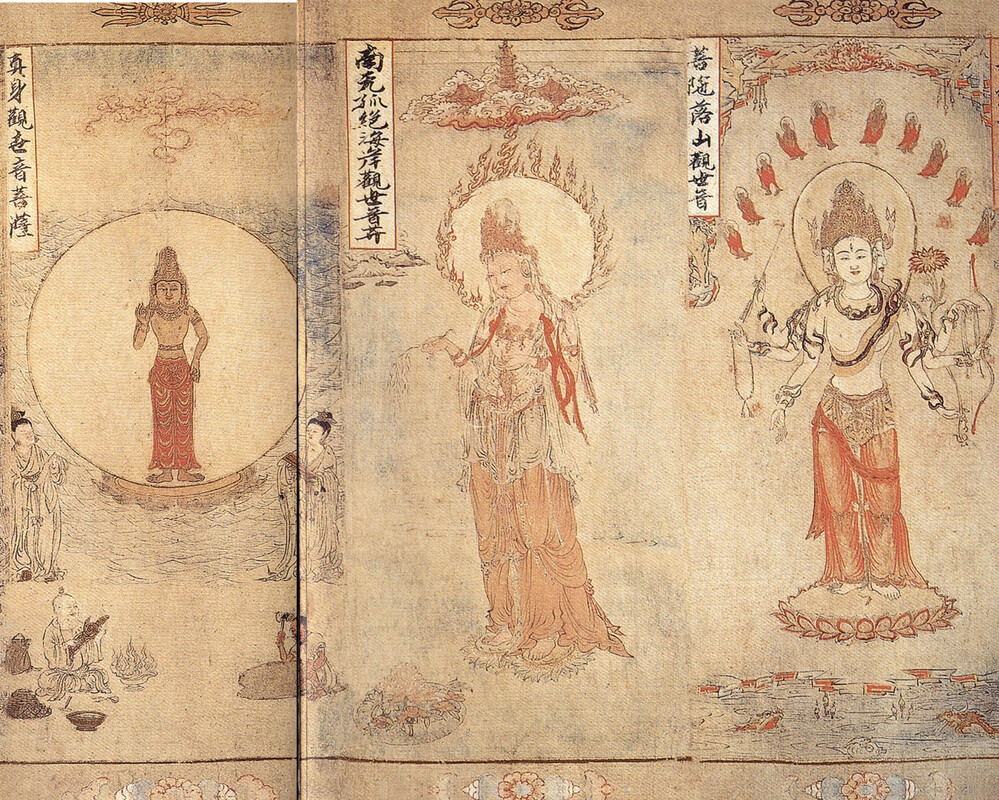Avalokiteśvara wears a red skirt, the folds of which are tinged with gold. His flesh is gold in color, and he is naked above the waist except for jewelry. His headdress, in which there is no small Buddha, is a complicated red and gold affair. He stands in a large, circular aureole, pale blue, with a narrow gold rim. Under his feet is a lotus, the top of which is yellow, with grey petals, resting on the waves of the sea. Above whirl maroon clouds.
On the shore to the right is a female figure in a white robe holding a red book, and to the left is another holding a scarf.
In the foreground two men are at work making sculpture. To the right is a dark-skinned man — possibly an Indian sculptor working in Yunnan — with a huge piece of wood and a hatchet. To the left a pale-skinned man in a white robe, holds in his hands a small image, doubtless cast in metal, of our Avalokiteśvara. Nearby are scissors, hammer, a bowl, a bag, a basket of charcoal, and a dish from which issue flames. The dark-skinned man might instead be the village head-man beating his drum, a much more likely element in the scene than an irrelevant sculptor.
真身觀世音菩薩。 Avalokiteśvara Bodhisattva, whose body is Truth |
Avalokiteśvara, a normal flesh color, stands on two pale blue lotuses, holding a willow branch in his right hand and a flask in his left. He has a red-gold headdress without any dhyani Buddha. He wears a dull orange skirt, a green-grey overskirt, and a pale maroon girdle, with red-gold bracelets, necklace, and earrings. He has the ūrṇā, and a moustache and goatee. His halo is pale blue, edged with flames. All the colors are faded and worn, Above are seen a pagoda and the roofs of two temples rising from a mass of shaded maroon clouds.
Avalokiteśvara is standing by the shore. Rocks are seen toward the upper left. In the foreground to the right is a large glass bowl containing peonies.
南无孤絕海岸觀世音菩薩。 Adoration to Avalokiteśvara, the solitary crosser of the seashore
The theme of crossing over, as a metaphor for salvation, was one of the timeless clichés of Buddhism. |
The figure is three-headed, of a pale flesh color; his left face grey and his right one a deeper flesh tone. Fangs extend over the lower lip on the two side faces, and each face has three eyes. He stands on a maroon lotus. His necklace and bracelets on both upper and lower arms are snakes, some dark crimson, others blue. A yellow cloth is draped over his left shoulder; on it is a crimson snake. He wears a pink skirt, gold anklets and knee-trimmings, a tiger-skin girdle over which is a belt of gold, and a red scarf with a design in crimson.
In the background is a rocky landscape. Above the divinity hangs a maroon flower canopy. Just above the small, pale green oval halo are seen standing figures, of the Buddhas of the Ten Directions, each in a red robe.
Below is a pool with a rocky shore, In the center is a conch shell, with a fish's head to each side. Between the head and the conch on each side are three unidentified objects issuing from the water.
The attributes and mudrās are:
left hand
1. Lasso
2. Bow
3. Maroon lotus
right hand
1. Arrow
2. Rosary
3. Makes the varada mudrā
普陁落山觀世音。 Avalokiteśvara of Mount Potalaka
The present figure is entirely unlike all the other representations of the Avalokiteśvara (or the Guanyin) of Mount Potalaka. Potalaka was imagined as lying of the coast of Southern India. The Chinese equivalent, Putuo Shan, is also in the South, offshore from Ningpo. In the temples there the images are of a gracious feminine divinity, often called Nanhai Guanyin, or "Guanyin of the Southern Seas". |



